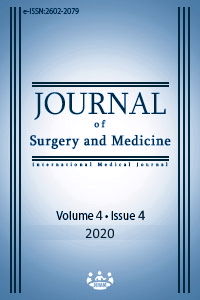A comparison of peri-articular injection and femoral block for pain management after total knee arthroplasty: A prospective cohort study
Keywords:
Peri-articular injection, Femoral nerve block, Total knee arthroplasty, Pain managementAbstract
Aim: Though Total knee arthroplasty (TKA) is an effective treatment method for osteoarthritis, insufficient postoperative pain control negatively affects patients’ satisfaction and functional results. The aim of this study is to compare the effects of intraoperative peri-articular injection and postoperative single-dose femoral nerve block on functional results, the need for analgesia, and pain in the short-term following total knee arthroplasty (TKA).
Methods: Thirty-one patients who received peri-articular injection (PAI) during TKA and 38 who were administered a single dose of femoral nerve block (FNB) postoperatively were evaluated. In both groups, an intravenous patient-controlled analgesia (PCA) device was utilized for postoperative analgesia. Analgesia demand and the amount administered from the PCA in the first 24 hours were recorded. For the evaluation of the level of postoperative pain, a visual analog scale (VAS) was used at rest at 2nd, 4th, 8th, 12th, and 24th hours, and dynamic VAS was used at the 24th hour to assess pain with mobilization. Range of movement (ROM) was recorded with the measurements of active flexion and extension angles at the first, second and third postoperative days.
Results: The resting VAS scores at the 2nd, 4th, 8th, and 24th hours were significantly lower in the PAI group than in the FNB group (P=0.032, P=0.037, P=0.014, P=0.004, respectively). The number of patients’ demands on the PCA for pain relief and the number of doses administered were higher in the FNB group. The ROM values measured on postoperative days 1, 2, and 3 were insignificantly greater in the PAI patients (P=0.956, P=0.103, P=0.162, respectively).
Conclusion: The peri-articular injection technique, when used appropriately, is easy to apply with a low-side effect profile. Therefore, it can be considered a safe and effective analgesia method providing a higher level of patient comfort and greater range of movement.
Downloads
References
Parvataneni HK, Shah VP, Howard H, Cole N, Ranawat AS, Ranawat CS. Controlling pain after total hip and knee arthroplasty using a multimodal protocol with local periarticular injections: a prospective randomized study. The Journal of Arthroplasty. 2007;22(6):33-8.
Ng FY, Ng JKF, Chiu KY, Yan CH, Chan CW. Multimodal periarticular injection vs continuous femoral nerve block after total knee arthroplasty: a prospective, crossover, randomized clinical trial. The Journal of Arthroplasty. 2012;27(6):1234-8.
Cansabuncu S , Yilmaz C , Cansabuncu G, Çağlayan U, Karasu D. The effect of pre-incisional wound site infiltration with multimodal analgesia on postoperative pain in total knee arthroplasty. East J Med Sci. 2019;4(4):144-8.
Vendittoli PA, Makinen P, Drolet P, Lavigne M, Fallaha M, Guertin MC, et al. A multimodal analgesia protocol for total knee arthroplasty: a randomized, controlled study. JBJS. 2006;88(2):282-9.
Turnbull ZA, Sastow D, Giambrone GP, Tedore T. Anesthesia for the patient undergoing total knee replacement: current status and future prospects. Local and Regional Anesthesia. 2017;10:1.
Rosero EB, Joshi GP. Preemptive, preventive, multimodal analgesia: what do they really mean? Plastic and Reconstructive Surgery. 2014;134(4S-2):85-93.
Dye SF, Vaupel GL, Dye CC. Conscious neurosensory mapping of the internal structures of the human knee without intraarticular anesthesia. Am J Sports Med. 1998;26(6):773–7.
Guild GN, Galindo RP, Marino J, Cushner FD, Scuderi GR. Periarticular regional analgesia in total knee arthroplasty: a review of the neuroanatomy and injection technique. Orthopedic Clinics of North America. 2015;46(1):1-8.
Motififard M, Omidian A, Badiei S. Pre-emptive injection of peri-articular-multimodal drug for post-operative pain management in total knee arthroplasty: a double-blind randomized clinical trial. International orthopaedics. 2017;41(5):939-47.
Coda BA, Hill HF, Hunt EB, Kerr EB, Jacobson RC, Chapman CR. Cognitive and motor function impairments during continuous opioid analgesic infusions. Human Psychopharmacology: Clinical and Experimental. 1993;8(6):383-400.
Duthie DJ, Nimmo WS. Adverse effects of opioid analgesic drugs. Br J Anaesth. 1987;59:61-77.
Tsukada S, Wakui M, Hoshino A. Pain control after simultaneous bilateral total knee arthroplasty: a randomized controlled trial comparing periarticular injection and epidural analgesia. JBJS. 2015;97(5):367-73.
Kovalak E, Doğan AT, Üzümcügil O, Obut A, Yildiz AS, Kanay E, et al. A comparison of continuous femoral nerve block and periarticular local infiltration analgesia in the management of early period pain developing after total knee arthroplasty. Acta Orthop Traumatol Turc. 2015;49(3):260-6.
Sharma S, Iorio R, Specht LM, Davies-Lepie S, Healy WL. Complications of femoral nerve block for total knee arthroplasty. Clinical Orthopaedics and Related Research. 2010;468(1):135.
Youm YS, Do Cho S, Cho HY, Hwang CH, Jung SH, Kim KH. Preemptive femoral nerve block could reduce the rebound pain after periarticular injection in total knee arthroplasty. The Journal of Arthroplasty. 2016;31(8):1722-6.
Russo MW, Parks NL, Hamilton WG. Perioperative Pain Management and Anesthesia: A Critical Component to Rapid Recovery Total Joint Arthroplasty. The Orthopedic clinics of North America. 2017;48(4):401-5.
Sakai N, Inoue T, Kunugiza Y, Tomita T, Mashimo T. Continuous femoral versus epidural block for attainment of 120° knee flexion after total knee arthroplasty: a randomized controlled trial. J Arthroplasty. 2013;28:807-14.
Gómez-Cardero P, Rodríguez-Merchán EC. Postoperative analgesia in TKA: ropivacaine continuous intraarticular infusion. Clin Orthop Relat Res. 2010;468:1242–7.
Downloads
- 443 770
Published
Issue
Section
How to Cite
License
Copyright (c) 2020 Gökhan Cansabuncu, Seda Cansabuncu
This work is licensed under a Creative Commons Attribution-NonCommercial-NoDerivatives 4.0 International License.
















